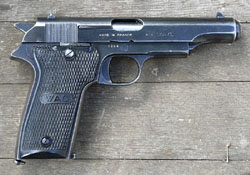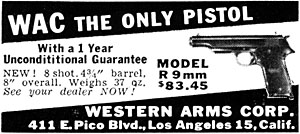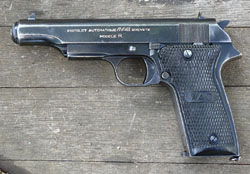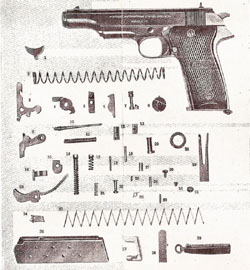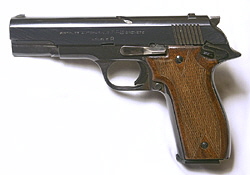 |
||||||||||||||||||||||||||||||||||||||||||||||||||||||||||||||||||||||||||||||||||||||||||||||||||||||||||||||||||||||||||
|
|
||||||||||||||||||||||||||||||||||||||||||||||||||||||||||||||||||||||||||||||||||||||||||||||||||||||||||||||||||||||||||
|
The M.A.B. Model R by Ed Buffaloe
According to Huon, the Model R was first manufactured on 23 July 1950, chambered for the French military cartridge known as the .32 French Long. MAB was hoping to interest the French government in the gun for military use, but was apparently unaware that the military had already determined to switch to the 9mm Parabellum cartridge. The Model R was introduced in a 7.65mm Browning (.32 ACP) version on 1 February 1951, and in 9mm Parabellum a year later in February of 1952. A version in 9mm Browning Short (.380 ACP) was was also released, but I am uncertain of the exact date. The target version, which I refer to as the R 22, chambered for the .22 LR, became available in 1954. The Model R received very little attention in U.S. gun magazines or anywhere else. I have never seen a parts diagram or a schematic for a Model R in any magazine or on any website. The first listing I could find for it in Gun Digest was in the 1958 edition. Josserand says the R Series was made for 12 years, which would mean production ended in 1963 or 1964. However, I possess an MAB catalog for 1966 which still lists the Model R 22. The Model R series guns were imported into the United States by the Western Arms Company of Los Angeles (later known as the Winfield Arms Corporation), and most were stamped “Made in France for W.A.C.,” with the “WAC” logo on the grips. Late model R Para imports into the U.S. were called “Le Militaire,” though the one pictured in the 1963 Gun Digest is clearly marked “Modele R” on the left side and has MAB on the grips.
Josserand states that each model in the R Series (.32 ACP, .32 French Long, .380, and 9mm) came in a different barrel length and the Model R 22 was available in three barrel lengths: 4-1/2”, 6-3/4”, and 7-3/16”. He does not say if the frame size differs on the various models, nor does he give the number of rounds each magazine holds, though Huon does give some of this information. The R 32 is 4mm longer than a Model D due to its enlarged grip tang--otherwise the two guns would be identical in size. The R Para is 30mm longer than the Model D. Both the R 32 and the R Para have the same military-style lanyard as the Model D.
The R Para has a small spring in the frame directly behind the barrel step which pushes the barrel forward against the retaining pin. During recoil, the barrel is able to move with the slide against this spring for about 1/4 inch before it is stopped by the frame and the slide continues rearward by itself. The barrel is prevented from moving forward by the crosspin, but can move backward against the extra spring, which serves as a recoil buffer (similar to the buffer spring in the 1908 Bayard).
At the range, the R Para exhibited the same stiff trigger I have found on other early M.A.B.s--it has almost identical lockwork. By concentrating, I was able to put a few rounds from each magazine in the bullseye at 30 feet, but inevitably the rest were flyers. The barrel is very closely fitted in the slide, so I think the gun has the potential to be quite accurate, but is limited by its less-than-optimal trigger. The recoil was not unreasonable--certainly less than a .357. The first time I inserted a loaded magazine, the slide did not close--I simply pulled back and released and it chambered the first round. Subsequently the breech closed automatically each time I inserted a magazine. When I cleaned the gun, I discovered that the screw holding the slide lock mechanism was a bit loose, so I tightened it. The R Para fed and ejected standard hardball 9mm ammunition with no problems.
Field Stripping:
As on earlier M.A.B. pistols, the grip screws come in two lengths--the shorter screw goes on top. During reassembly, you must push the barrel back against the spring in the frame in order to insert the retaining pin. The “R Para Experimental” This gun is listed in 2005 Standard Catalog of Firearms. It is a prototype for the P8 pistol of 1966, which has a rotating barrel with two locking lugs, somewhat similar to the 1907 Savage. Some confusion surrounds its origin, not least because it has the slide inscription of a Model R. Additionally, Huon says of the Model R (loosely translated): “It works the breech after the round leaves the barrel, and then the gun recoils and unlocks the cylinder head after a helical rotation.” This is clearly a description of the so-called “R Para Experimental” P8 prototype and not a description of the Model R in 9mm Parabellum. Perpetuating the error, Bastié and Casanova also describe “A new model R, this time with a locked breech, presented in October 1951. It chambers the 9 mm Parabellum. The weapon is larger and functions by short recoil of the barrel, with a helical rotational movement.” Again, the authors are referring to the later P8 of 1966, not the R8 of 1951. * If you have a high serial number Model R Para, please e-mail me. I have had responses from two individuals--one has serial number 1038, and the other said his is “in the 1200 range.” If you have an R Para Experimental, I would greatly appreciate having more photographs of it. |
||||||||||||||||||||||||||||||||||||||||||||||||||||||||||||||||||||||||||||||||||||||||||||||||||||||||||||||||||||||||||
|
Copyright 2015 by Ed Buffaloe. All rights reserved. |
||||||||||||||||||||||||||||||||||||||||||||||||||||||||||||||||||||||||||||||||||||||||||||||||||||||||||||||||||||||||||
|
||||||||||||||||||||||||||||||||||||||||||||||||||||||||||||||||||||||||||||||||||||||||||||||||||||||||||||||||||||||||||
|
|
||||||||||||||||||||||||||||||||||||||||||||||||||||||||||||||||||||||||||||||||||||||||||||||||||||||||||||||||||||||||||
|
|
||||||||||||||||||||||||||||||||||||||||||||||||||||||||||||||||||||||||||||||||||||||||||||||||||||||||||||||||||||||||||
